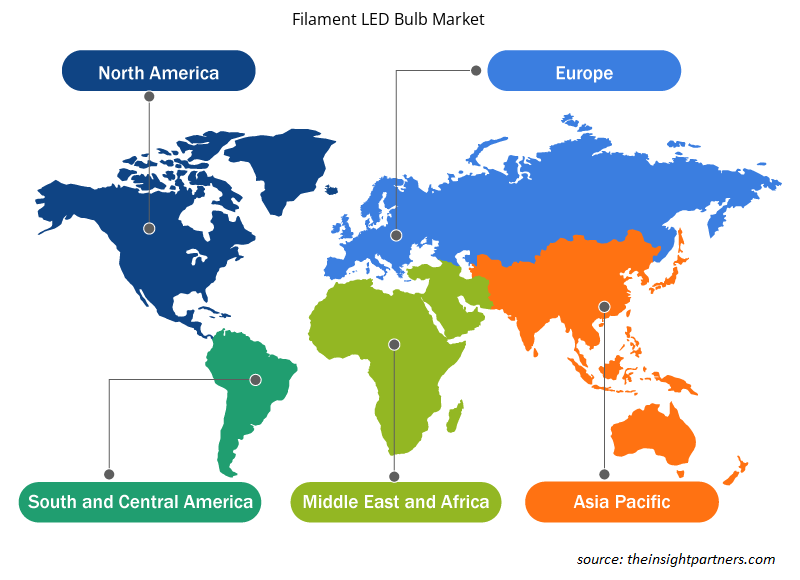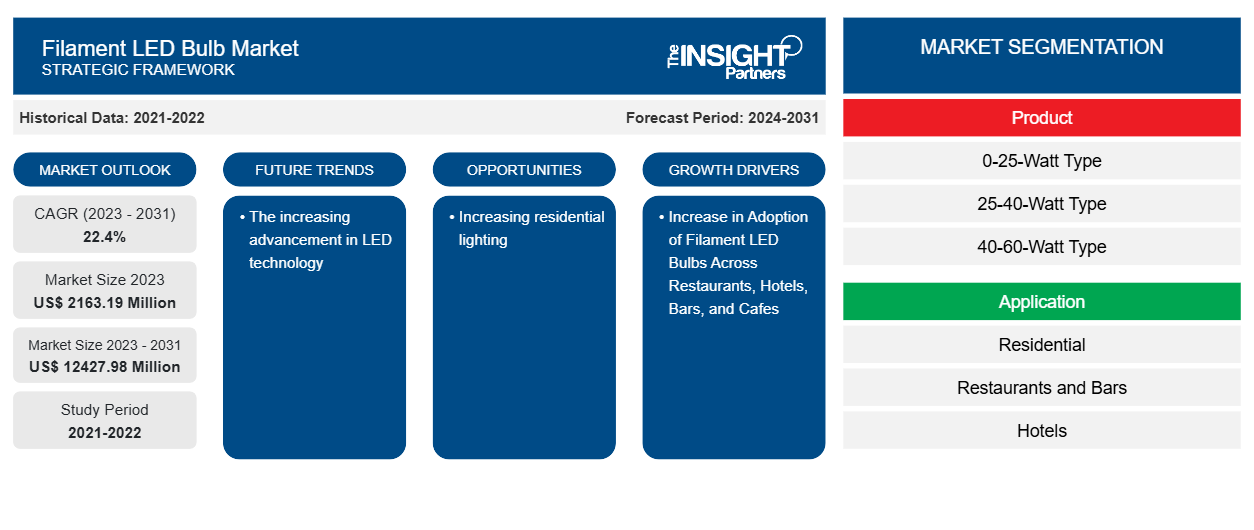预计到 2031 年,灯丝 LED 灯泡市场规模将从 2023 年的 21.6319 亿美元增至 124.2798 亿美元。预计 2023-2031 年期间市场复合年增长率将达到 22.4%。LED 技术的不断进步可能仍是市场的主要趋势。
灯丝型 LED 灯泡市场分析
市场的增长归因于不同地区的商业和住宅建设项目数量的增加。此外,人们对房屋翻修和改造活动的兴趣增加(这可能与政府(特别是在工业化国家)的支持增加有关)也推动了对灯丝 LED 灯泡的需求。消费者收入水平的提高、生活方式的改变以及室内装饰方面对多元文化的接受都促进了这种转变。
灯丝型 LED 灯泡市场概况
LED 灯丝灯泡增强了白炽灯泡的外观和光散射,同时使用 LED 技术提供高效照明和可靠的性能。LED 灯丝灯泡,通常称为爱迪生灯泡,通过透明玻璃外壳显示大型发光灯丝,类似于老式白炽灯或复古灯。LED 灯丝灯泡具有传统白炽灯泡的外观,同时提供节能照明和传统 LED 照明的所有其他优点。LED 灯丝灯泡的使用寿命比白炽灯泡更长。
定制此报告以满足您的需求
您可以免费定制任何报告,包括本报告的部分内容、国家级分析、Excel 数据包,以及为初创企业和大学提供优惠和折扣
- 获取此报告的关键市场趋势。这个免费样品将包括数据分析,从市场趋势到估计和预测。
灯丝 LED 灯泡市场驱动因素和机遇
餐厅、酒店、酒吧和咖啡馆中灯丝 LED 灯泡的采用率增加
照明是餐厅和咖啡厅整体设计中的重要元素。在咖啡厅、酒吧和餐厅中,通常认为 150 勒克斯的光强度是合适的。其他区域需要 100 勒克斯,食物储藏区需要 150 勒克斯,洗涤区需要 300 勒克斯,烹饪区需要 500 勒克斯。餐厅采用四种类型的照明:一般照明、重点照明、装饰照明和自然照明。在咖啡厅或餐厅中,一般照明是最重要的方面。通过同时按一定顺序放置照明设备可实现均匀照明。如果餐厅的整体装饰得体,顾客会觉得餐厅更受欢迎。重点照明可用于吸引人们对餐厅的主要或花哨方面的注意,包括装饰、植物、桌子或商品。装饰照明是指用于完成设计的照明组件。传统和现代照明可用于创造装饰照明。因此,餐厅、酒店、酒吧和咖啡馆使用的各种照明技术正在推动灯丝 LED 灯泡的采用,从而促进市场增长。
增加住宅照明
住宅区照明正在增加。家庭中 LED 灯泡的使用与其他家庭特征不同,例如家庭收入和所有权。在年收入低于 20,000 美元的家庭中,39% 表示 LED 灯泡是他们的主要室内照明选择,而 54% 的年收入 100,000 美元或以上的家庭在 2020 年主要使用 LED 灯泡。灯丝 LED 灯泡在住宅区广泛使用。因此,住宅照明的增加为灯丝 LED 灯泡市场创造了更多机会。
灯丝 LED 灯泡市场报告细分分析
有助于得出灯丝 LED 灯泡市场分析的关键部分是产品和应用。
- 根据产品,灯丝 LED 灯泡市场分为 0-25 瓦型、25-40 瓦型、40-60 瓦型和 60 瓦以上型。0-25 瓦型在 2023 年占据了较大的市场份额。
- 根据应用,市场分为住宅、餐厅和酒吧、酒店、咖啡馆和其他。
灯丝 LED 灯泡市场份额按地区分析
灯丝LED灯泡市场报告的地理范围主要分为五个区域:北美、亚太、欧洲、中东和非洲、南美和中美。
2023 年,欧洲引领了灯丝 LED 灯泡市场。在欧洲,国家能源效率行动计划 (NEEAP) 和国家能源效率行动计划 (NEEAP) 等旨在促进对住宅和商业建筑维护和翻新的投资。此外,消费者愿意在生活空间的造型上花费大量资金,这吸引了他们对地毯和地毯等家居产品以及提升室内美感的先进和时尚照明系统的关注。
灯丝 LED 灯泡市场区域洞察
Insight Partners 的分析师已详尽解释了预测期内影响灯丝 LED 灯泡市场的区域趋势和因素。本节还讨论了北美、欧洲、亚太地区、中东和非洲以及南美和中美洲的灯丝 LED 灯泡市场细分和地理位置。

- 获取灯丝 LED 灯泡市场的区域特定数据
灯丝 LED 灯泡市场报告范围
| 报告属性 | 细节 |
|---|---|
| 2023 年的市场规模 | 21.6319亿美元 |
| 2031 年市场规模 | 124.2798 亿美元 |
| 全球复合年增长率(2023 - 2031) | 22.4% |
| 史料 | 2021-2022 |
| 预测期 | 2024-2031 |
| 涵盖的领域 | 按产品
|
| 覆盖地区和国家 | 北美
|
| 市场领导者和主要公司简介 |
|
灯丝 LED 灯泡市场参与者密度:了解其对业务动态的影响
灯丝 LED 灯泡市场正在快速增长,这得益于终端用户需求的不断增长,而这些需求又源于消费者偏好的不断变化、技术进步以及对产品优势的认识不断提高等因素。随着需求的增加,企业正在扩大其产品范围,进行创新以满足消费者的需求,并利用新兴趋势,从而进一步推动市场增长。
市场参与者密度是指在特定市场或行业内运营的企业或公司的分布情况。它表明在给定市场空间中,相对于其规模或总市场价值,有多少竞争对手(市场参与者)存在。
在灯丝 LED 灯泡市场运营的主要公司有:
- 克朗普顿灯具有限公司
- 哈维尔印度有限公司
- Wipro 消费照明
- 曼佳美
- 欧司朗有限公司
- 飞利浦照明控股公司
免责声明:上面列出的公司没有按照任何特定顺序排列。

- 获取灯丝 LED 灯泡市场顶级关键参与者概览
灯丝 LED 灯泡市场新闻和最新发展
灯丝 LED 灯泡市场通过收集一手和二手研究后的定性和定量数据进行评估,其中包括重要的公司出版物、协会数据和数据库。灯丝 LED 灯泡市场的一些发展情况如下:
- Feit Electric Company, Inc.(“Feit Electric”)是一家总部位于加利福尼亚州的全球领先照明和智能家居品牌,今天宣布其创新型可见白色灯丝灯泡获得一系列专利保护,即“白色灯丝专利”。
(来源:Trellix,新闻稿,2023 年 10 月。)
- 此外,Life on Products, Inc. 于 1 月发布了更多 LED 灯丝灯。(来源:PamTen Inc,新闻稿,2023 年 1 月)
灯丝 LED 灯泡市场报告覆盖范围和交付成果
“灯丝 LED 灯泡市场规模和预测(2021-2031 年)”报告对市场进行了详细分析,涵盖以下领域:
- 灯丝 LED 灯泡市场规模以及全球、区域和国家层面所有主要细分市场的预测,涵盖范围
- 灯丝 LED 灯泡市场趋势以及市场动态,如驱动因素、限制因素和关键机遇
- 详细的 PEST/波特五力分析和 SWOT 分析
- 灯丝 LED 灯泡市场分析,涵盖主要市场趋势、全球和区域框架、主要参与者、法规和最新市场发展
- 行业格局和竞争分析,涵盖市场集中度、热点图分析、知名参与者以及灯丝 LED 灯泡市场的最新发展
- 详细的公司简介
- 历史分析(2 年)、基准年、预测(7 年)及复合年增长率
- PEST 和 SWOT 分析
- 市场规模价值/数量 - 全球、区域、国家
- 行业和竞争格局
- Excel 数据集



Report Coverage
Revenue forecast, Company Analysis, Industry landscape, Growth factors, and Trends

Segment Covered
This text is related
to segments covered.

Regional Scope
North America, Europe, Asia Pacific, Middle East & Africa, South & Central America

Country Scope
This text is related
to country scope.
常见问题
Europe dominates the filament LED bulb market.
The increase in adoption of filament led bulbs across restaurants, hotels, bars, and cafes and the increasing residential lighting are the major factors that propel the global filament LED bulb market.
The increasing advancement in LED technology is anticipated to play a significant role in the global filament LED bulb market in the coming years.
The key players holding majority shares in the global filament LED bulb market are Crompton Lamps Ltd, Havells India Ltd., Wipro Consumer Lighting, MEGAMAN, OSRAM GmbH, Signify Holding (Philips), Feilo Sylvania Europe Limited, UKLED, Verbatim Americas LLC, and Seoul Semiconductor Co., Ltd.
The global filament LED bulb market is expected to reach US$ 12427.98 million by 2031.
The expected CAGR of the global filament LED bulb market is 22.4%.
Trends and growth analysis reports related to Electronics and Semiconductor : READ MORE..
The Insight Partners performs research in 4 major stages: Data Collection & Secondary Research, Primary Research, Data Analysis and Data Triangulation & Final Review.
- Data Collection and Secondary Research:
As a market research and consulting firm operating from a decade, we have published and advised several client across the globe. First step for any study will start with an assessment of currently available data and insights from existing reports. Further, historical and current market information is collected from Investor Presentations, Annual Reports, SEC Filings, etc., and other information related to company’s performance and market positioning are gathered from Paid Databases (Factiva, Hoovers, and Reuters) and various other publications available in public domain.
Several associations trade associates, technical forums, institutes, societies and organization are accessed to gain technical as well as market related insights through their publications such as research papers, blogs and press releases related to the studies are referred to get cues about the market. Further, white papers, journals, magazines, and other news articles published in last 3 years are scrutinized and analyzed to understand the current market trends.
- Primary Research:
The primarily interview analysis comprise of data obtained from industry participants interview and answers to survey questions gathered by in-house primary team.
For primary research, interviews are conducted with industry experts/CEOs/Marketing Managers/VPs/Subject Matter Experts from both demand and supply side to get a 360-degree view of the market. The primary team conducts several interviews based on the complexity of the markets to understand the various market trends and dynamics which makes research more credible and precise.
A typical research interview fulfils the following functions:
- Provides first-hand information on the market size, market trends, growth trends, competitive landscape, and outlook
- Validates and strengthens in-house secondary research findings
- Develops the analysis team’s expertise and market understanding
Primary research involves email interactions and telephone interviews for each market, category, segment, and sub-segment across geographies. The participants who typically take part in such a process include, but are not limited to:
- Industry participants: VPs, business development managers, market intelligence managers and national sales managers
- Outside experts: Valuation experts, research analysts and key opinion leaders specializing in the electronics and semiconductor industry.
Below is the breakup of our primary respondents by company, designation, and region:

Once we receive the confirmation from primary research sources or primary respondents, we finalize the base year market estimation and forecast the data as per the macroeconomic and microeconomic factors assessed during data collection.
- Data Analysis:
Once data is validated through both secondary as well as primary respondents, we finalize the market estimations by hypothesis formulation and factor analysis at regional and country level.
- Macro-Economic Factor Analysis:
We analyse macroeconomic indicators such the gross domestic product (GDP), increase in the demand for goods and services across industries, technological advancement, regional economic growth, governmental policies, the influence of COVID-19, PEST analysis, and other aspects. This analysis aids in setting benchmarks for various nations/regions and approximating market splits. Additionally, the general trend of the aforementioned components aid in determining the market's development possibilities.
- Country Level Data:
Various factors that are especially aligned to the country are taken into account to determine the market size for a certain area and country, including the presence of vendors, such as headquarters and offices, the country's GDP, demand patterns, and industry growth. To comprehend the market dynamics for the nation, a number of growth variables, inhibitors, application areas, and current market trends are researched. The aforementioned elements aid in determining the country's overall market's growth potential.
- Company Profile:
The “Table of Contents” is formulated by listing and analyzing more than 25 - 30 companies operating in the market ecosystem across geographies. However, we profile only 10 companies as a standard practice in our syndicate reports. These 10 companies comprise leading, emerging, and regional players. Nonetheless, our analysis is not restricted to the 10 listed companies, we also analyze other companies present in the market to develop a holistic view and understand the prevailing trends. The “Company Profiles” section in the report covers key facts, business description, products & services, financial information, SWOT analysis, and key developments. The financial information presented is extracted from the annual reports and official documents of the publicly listed companies. Upon collecting the information for the sections of respective companies, we verify them via various primary sources and then compile the data in respective company profiles. The company level information helps us in deriving the base number as well as in forecasting the market size.
- Developing Base Number:
Aggregation of sales statistics (2020-2022) and macro-economic factor, and other secondary and primary research insights are utilized to arrive at base number and related market shares for 2022. The data gaps are identified in this step and relevant market data is analyzed, collected from paid primary interviews or databases. On finalizing the base year market size, forecasts are developed on the basis of macro-economic, industry and market growth factors and company level analysis.
- Data Triangulation and Final Review:
The market findings and base year market size calculations are validated from supply as well as demand side. Demand side validations are based on macro-economic factor analysis and benchmarks for respective regions and countries. In case of supply side validations, revenues of major companies are estimated (in case not available) based on industry benchmark, approximate number of employees, product portfolio, and primary interviews revenues are gathered. Further revenue from target product/service segment is assessed to avoid overshooting of market statistics. In case of heavy deviations between supply and demand side values, all thes steps are repeated to achieve synchronization.
We follow an iterative model, wherein we share our research findings with Subject Matter Experts (SME’s) and Key Opinion Leaders (KOLs) until consensus view of the market is not formulated – this model negates any drastic deviation in the opinions of experts. Only validated and universally acceptable research findings are quoted in our reports.
We have important check points that we use to validate our research findings – which we call – data triangulation, where we validate the information, we generate from secondary sources with primary interviews and then we re-validate with our internal data bases and Subject matter experts. This comprehensive model enables us to deliver high quality, reliable data in shortest possible time.


 获取此报告的免费样本
获取此报告的免费样本